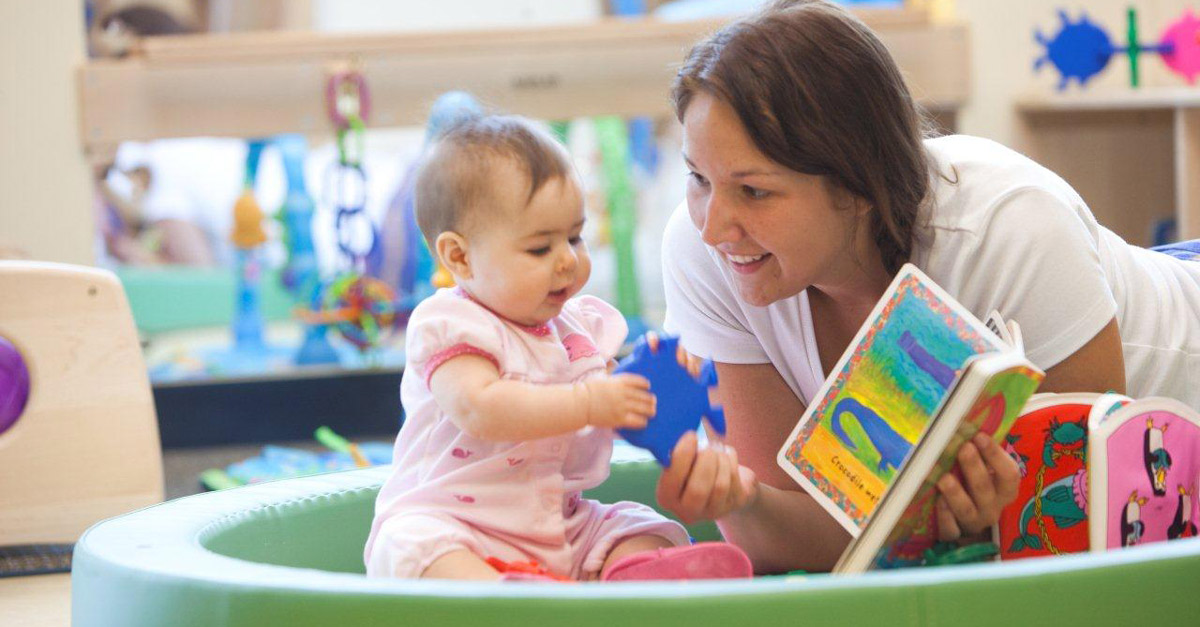
Parents have many options when it comes to choosing the right child care for their kids. Income, schedules, and educational philosophy all play a role in how each family figures out what works for them. Often the choice comes down to home-based child care vs. center-based child care, and recent reports like a Harvard University study found that “center-based care is superior to home-based care for many children.” Center-based kids often demonstrate better vocabulary skills and higher social and emotional development. So what are some of the other benefits of center-based child care?
Child care center locations are often close to workplaces.
Center-based care is often located closer to places where people work—which can be a comfort for parents. If there is an issue during the day, they can respond quickly. Also this proximity allows parents to visit their child during the day—which could be especially helpful for breastfeeding mothers. If the center is close enough, she can breastfeed her baby at the program and reduce the number of pumping sessions needed each day.
Child care centers are more reliable.
Child care centers will be open and on time—always. If one teacher is sick and unable to provide care, additional teachers can fill in so that parents aren’t left scrambling. Unlike home-based care, there will rarely be a day when parents have to rearrange their schedules or miss a day of work in order to compensate.
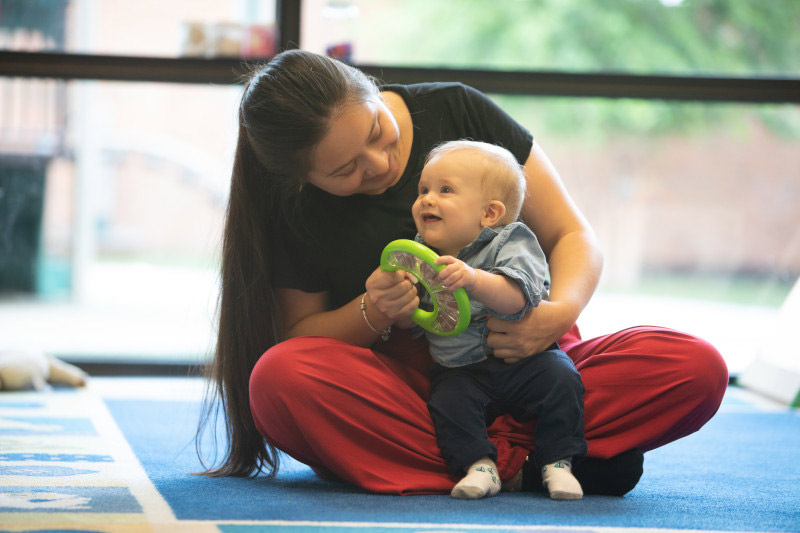
Child care centers provide high quality care.
Center-based child care, like Bright Horizons, which has over 1,000 centers worldwide, often employ well-educated and trained caregivers. The teachers in this type of child care must be certified and pass a background check—plus many have a degree in education and take ongoing classes to fulfill requirements. Child care centers are regularly inspected for licensing purposes and a director oversees the entire center.
Child care centers have a school-like environment.
For children in toddler through pre-kindergarten programs, center-based child care offers a more structured schedule as well as a school-like environment—which can be especially beneficial for preschoolers who are preparing for kindergarten. In fact, parents often choose a child care center for its social and learning environment because it functions as an early introduction to the classroom—without the pressure of being graded. Also, children interact with peers which helps them develop important social skills, such as sharing, taking turns, negotiating, and self-control. It helps them to function in groups, to understand social norms, and ultimately allows them to learn from each other.
Children in an infant program take full advantage of the social interactions and enriching learning environments of center-based child care; however, caregivers develop personalized care plans to support the daily schedules, nutritional guidelines, and other unique needs of these little learners.
Child care centers offer an enriched curriculum.
Child care centers are more likely to have an educationally enriched and age-appropriate curriculum that encourages literacy, language development, and social/emotional development. Many centers offer opportunities like cooking, dance, music, or foreign language classes. Plus, they are more likely to use age-appropriate technology (computers, iPads, and smartboards) to assist learning, which is not as common in home-based care.
Browse through the magazine version of the Bright Horizons Child care guide.
Child care centers follow health and safety protocols.
Studies show that child care centers may enhance immunity. While the kids in center-based care might initially get sick more often, they are less likely to come down with sore throats and ear infections once they start elementary school. Plus, during COVID, centers like Bright Horizons have been meticulous about safety protocols. In addition, a center will likely have a secured entrance, pediatric first aid and CPR certified staff, and extensive evacuation and emergency response procedures. Parents can rest assured that all precautions are taken and that there is a substantial staff looking out for their little ones.
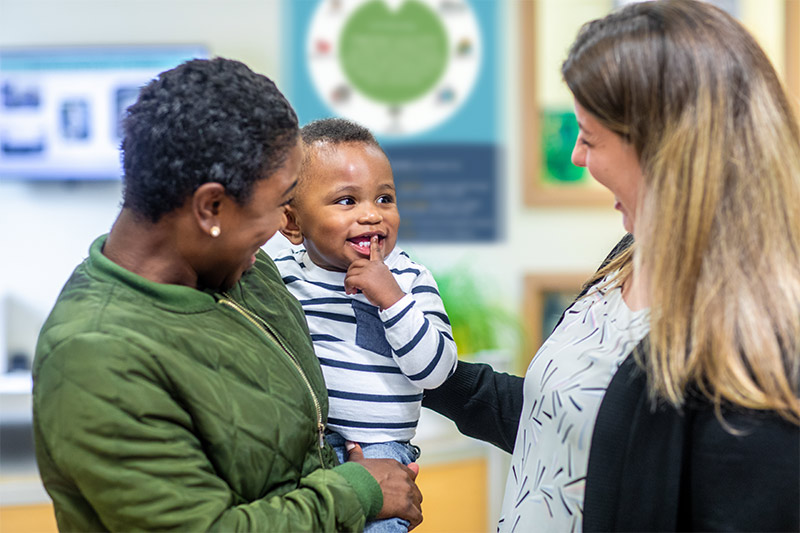
What parents need to know about center-based child care
Starting center-based child care is a major milestone for families. It’s often the first time that a child has left the full-time care of his parents, as well as the first time that parents have returned to a routine without their child. However, while center-based child care is often an exciting and liberating experience for families, the transition can be emotionally challenging—which is why it’s so important to prepare for the initial adjustment.
When is the right time to start center-based child care?
Many center-based child care centers accept infants as young as 6-weeks-old, but it’s up to each family to decide the right age to send their child. Some parents may want to wait longer to establish a secure attachment and adjust to their new life together. Maternity/paternity leave, work schedules, other child care options, and the temperament of the child can influence this decision. Also, because toddlers begin to experience separation anxiety around 18 months, a little before or after this stage might be a good option.
What should you bring to center-based child care?
Your center-based child care center should provide a list of necessary items, and there may be local licensing requirements that prevent you from bringing items such as glass bottles or bibs with ties. When in doubt, ask your individual center.
In general, it’s useful to make a checklist of the essentials: diapers (8-10 per day), wipes, change of clothing, bottles, baby food, and formula/breast milk. Also, don’t forget back-up formula in case of emergency (i.e. the power goes out and the breast milk isn’t kept cold). Older kids will likely have to bring their own snacks and lunch.
And don’t forget to label everything with your child’s name. It can also be helpful to include a feeding and naptime schedule for your child. A favorite toy or lovey can help your child feel comfortable in their new environment. Check with your child care center in advance to see what items are permitted. You can also consider sharing tips and instructions (her typical nap time, a song that calms her down, etc.) with your child’s teacher.
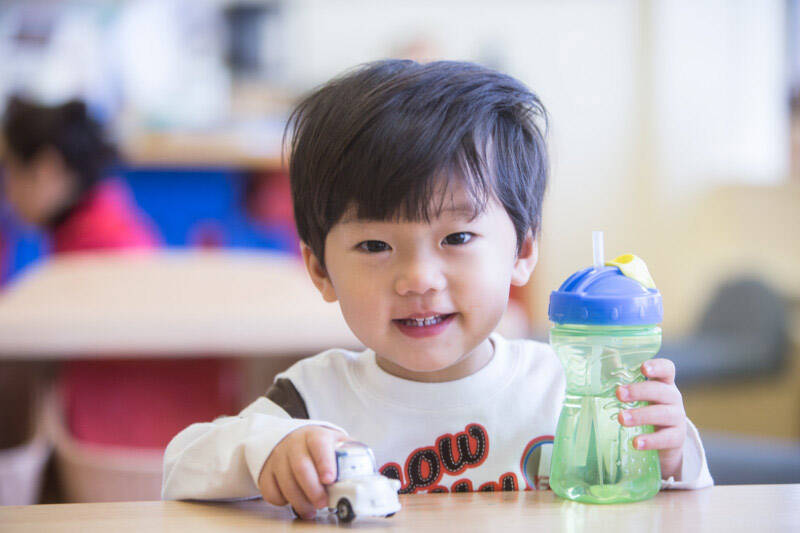
How can you prepare your child for the transition to center-based child care?
It’s essential to begin mentally preparing kids in advance. For example, they should visit the center, meet the teacher, explore the classroom, and play with the toys. Parents can also read them books about transitions—like The Kissing Hand by Audrey Penn or I Love You All Day Long by Francesca Rusackas.
Children thrive on routines, so try to drop off and pick up at the same time every day. Keep dinnertime and bedtime routines consistent. Parents should understand that new routines can be difficult for little ones—they may appear anxious or wake up more often during the night. A little extra bonding time can go a long way, so make sure to factor in time for reading, cuddling, or playing together, too.
How can you prepare yourself for the transition to center-based child care?
Even though you’re busy getting your child ready to take this big step, it’s important to make time to think about yourself, too. Get everything ready the night before. Set regular check-ins with your child’s teacher and/or find out what parent-communication already exists so you feel involved in the day-to-day routine. (Many child care centers now offer daily progress reports or apps with pictures.)
Finally, this is an emotional time for your family, so tears are completely normal. According to a survey conducted by Bright Horizons, working moms in leadership roles tend to bring out the best in their employees and are the top listeners on staff. Dropping your child off at child care might be stressful at first but it’s also an exciting new adventure that will benefit the whole family in the end.
How to find the best child care option for your family
Leaving your baby or young child in the care of someone else can be a daunting experience. But before you allow that anxiety to take over (Will my baby remember me? What if something happens to her?), keep in mind that studies have shown that quality child care can have a positive impact—socially, emotionally and cognitively. Plus, there are plenty of excellent child care options available these days—from nannies to babysitters to child care centers. All you have to do is decide which option is right for your family.
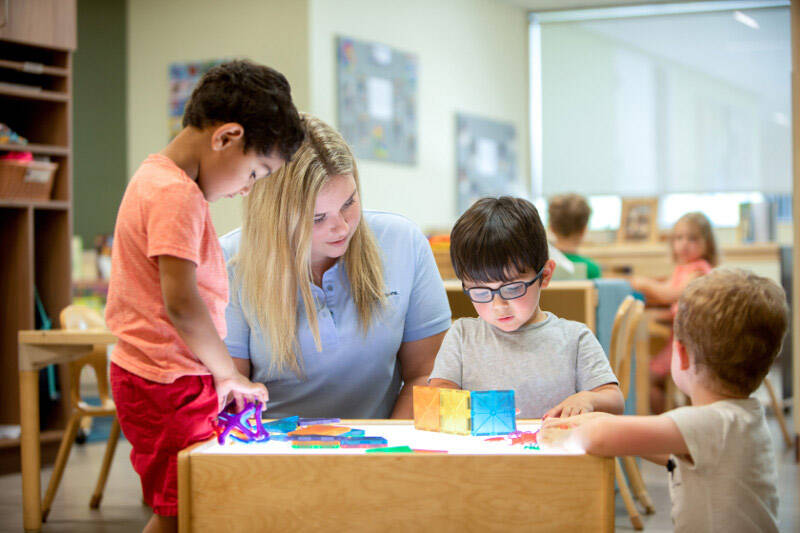
What are the child care options?
A child care center like Bright Horizons, which has more than 20 locations in the New York area, is a state-licensed facility where parents drop off their children for half or full days. These are a great choice for parents who have jobs with fixed hours or kids who benefit from structured schedules. They also provide socialization, and their teachers often have a degree in education, so kids transition easily from here into school.
In-home daycare is run out of a private home with hired caregivers and a smaller group of kids who are sometimes mixed ages, meaning siblings will most likely stay together. You also have the freedom to create a more flexible schedule, although these caregivers may not fulfill as many educational requirements as those in at a child care center.
A nanny (either live-in/au pair or live-out) provides one-on-one care and will really get to know your child. Nannies typically stay with a family for many years. One disadvantage of nanny care however is the fact that if your nanny goes down (flu or flat tire), or takes her much-deserved time off, you’ll need to recruit backup care or coordinate with your vacation time.
A relative caregiver is a family member who cares for your child, either at their home or yours. This can be an ideal and potentially free or cheaper situation for families—but it’s important to evaluate whether your relative is actually capable of the demanding needs of a baby and if the responsibility could start to feel like a burden. Will your relationship be able to survive the agreement? What happens when and if your relative can’t handle the care?
A babysitter is someone who takes care of a child in your home for a short period of time and is paid by the hour (averaging $15 per hour). They are often high schoolers, college students, or even teachers looking to make extra money, which means they may not be trained to care for babies and their availability isn’t always a given.
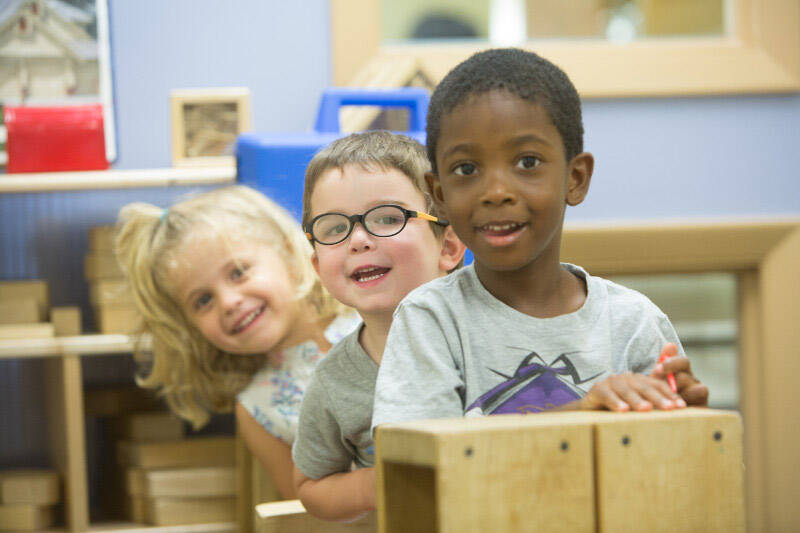
What is your budget?
Figuring out how much you can afford on child care could be the first and most important factor in your decision. For example, in-home care is typically less than child care centers. It’s also less than a full-time nanny, which requires a monthly fee, plus taxes, bonuses, and disability insurance.
What is your schedule?
It’s also important to factor in your own schedule. Is it flexible? Do you often work late hours unexpectedly? How close do you want your child to be to your home or workplace during the day? (And will the location of the child care be a problem if you don’t go into work that day?) Are you comfortable managing someone in your home and/or living in your home full-time? Do you need child care every day or just a few hours a week?
These are all helpful questions to ask yourself and your family at least two months before you go back to work. And once you’ve decided on the type of child care that works best for your family, you can find specific resources online at the National Association for the Education of Young Children (NAEYC) and your state’s government website—which should have a directory of licensed child care providers. Also, don’t be shy about asking parents in your community — at the playground or on Facebook. Most parents know how challenging it is to find the right child care option for your family—and will be happy to help.



